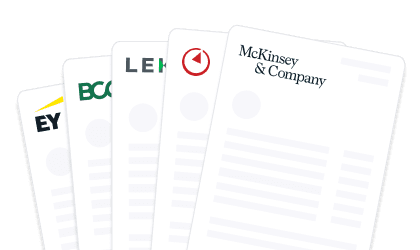The Business Situation Framework: A Key Tool in Consulting
Discover how the Business Situation Framework can help you become a more effective consultant.
Posted June 13, 2025

Join a free event
Learn from top coaches and industry experts in live, interactive sessions you can join for free.
Table of Contents
Consulting is a vital practice in any industry and involves helping clients solve complex problems, improve performance, and achieve their goals. With the ever-evolving nature of businesses, consultants are challenged to develop and adopt innovative approaches to problem-solving. The business situation framework has emerged as a critical tool in consulting, enabling consultants to understand business problems systematically. In this article, we explore the business situation framework and how it helps consultants in analyzing and solving problems.
Understanding the Business Situation Framework and its Purpose
The business situation framework is a structured approach used in consulting to understand and analyze complex business problems. It aims to provide a clear understanding of the situation, its root causes, and possible solutions. The framework helps build a common understanding among consultants, clients, and stakeholders, leading to better decision-making and efficient problem-solving. It also helps identify data gaps, develop hypotheses, and test assumptions.
One of the key benefits of using the business situation framework is that it allows consultants to break down complex problems into smaller, more manageable components. This makes it easier to identify the underlying causes of the problem and develop targeted solutions. Additionally, the framework can be customized to fit the specific needs of each client, ensuring that the analysis and recommendations are tailored to their unique situation.
Another important aspect of the business situation framework is that it encourages collaboration and communication among all stakeholders. By involving everyone in the process, from senior executives to front-line employees, the framework helps ensure that all perspectives are taken into account and that everyone is working towards a common goal. This can lead to increased buy-in and support for the proposed solutions, as well as a greater sense of ownership and accountability for the outcomes.
The Importance of a Structured Consulting Approach
A structured consulting approach is crucial in consistently delivering quality work to clients. It provides a framework for consultants to follow, ensuring that all critical aspects of the problem-solving process are addressed. A structured approach helps identify the problem, gather relevant information, analyze the situation, develop solutions, and implement action plans. It also ensures that consultants adequately communicate their findings and recommendations. The business situation framework provides this much-needed structure.
Another benefit of a structured consulting approach is that it helps consultants manage their time effectively. By following a set process, consultants can allocate their time efficiently, ensuring that they have enough time to complete each step of the problem-solving process. This approach also helps consultants prioritize their tasks, ensuring that they focus on the most critical aspects of the project first.
Furthermore, a structured consulting approach helps build trust with clients. Clients appreciate consultants who have a clear and organized approach to problem-solving. By following a structured approach, consultants can demonstrate their expertise and professionalism, which can help build long-term relationships with clients. This approach also helps consultants manage client expectations, ensuring that clients understand the process and the expected outcomes.
How the Business Situation Framework Helps Consultants Analyze Problems
The business situation framework involves a structured approach to analyze complex business problems. It starts with clearly defining the problem and its scope. Defining the problem provides a clear focus on the situation and ensures that the analysis is relevant and not clouded by irrelevant information. The next step is to conduct a thorough analysis of the situation, including understanding the root causes of the problem and identifying critical stakeholders. Analyzing the situation provides insights into the factors contributing to the problem and the potential impact of solutions. The last phase of the framework involves developing a range of solutions, testing and selecting the best one, and developing an implementation plan. By following this approach, consultants can provide accurate and effective solutions to the problems at hand.
One of the key benefits of using the business situation framework is that it helps consultants to communicate their findings and recommendations clearly and effectively. By breaking down the problem into its component parts and analyzing each one in detail, consultants can provide a comprehensive understanding of the situation to their clients. This, in turn, enables clients to make informed decisions about how to address the problem and implement the recommended solutions. Additionally, the framework provides a structured approach that can be applied to a wide range of business problems, making it a versatile tool for consultants to use in their work.
Step-by-Step Guide to Using the Business Situation Framework in Consulting
When using the business situation framework in consulting, it's necessary to follow a step-by-step approach. The first step is to identify the problem and its scope. This involves engaging with the client to understand the situation. Once the problem is defined, the consultant needs to gather relevant information from multiple sources to analyze the situation. This involves conducting interviews, analyzing data, and researching possible solutions. Next, the consultant needs to develop potential solutions and test them to determine their feasibility. Finally, the consultant needs to develop a detailed implementation plan. This involves defining specific activities, timelines, and resources required to implement the selected solution effectively.
It's important to note that the business situation framework is not a one-size-fits-all solution. The consultant needs to tailor the approach to the specific needs of the client and the situation at hand. This may involve modifying the steps or using additional tools and techniques to gather and analyze information.
Another key aspect of using the business situation framework is effective communication with the client. The consultant needs to keep the client informed throughout the process and ensure that they understand the proposed solutions and implementation plan. This involves presenting information in a clear and concise manner and addressing any concerns or questions the client may have.
Case Studies: Real-Life Examples of the Business Situation Framework in Action
Several consulting firms have successfully used the business situation framework to analyze and solve real-world business problems. For example, McKinsey & Company used the framework to help a non-profit organization increase its revenue by 20%. McKinsey used a structured approach to identify and develop a tailored solution that met the specific needs of the organization. Another example is when Bain & Company used the framework to identify opportunities for growth in a technology company. The process involved identifying the key areas where the company was underperforming, developing and testing potential solutions, and developing an implementation plan.
Tips for Implementing the Business Situation Framework in Your Consulting Practice
Implementing the business situation framework in your consulting practice requires discipline, attention to detail, and a structured approach. The following are some tips to help implement the framework successfully:
- Ensure that the client understands the process and actively participate in all steps
- Develop a comprehensive checklist to help guide you through the process
- Use visual aids to help present the findings to clients and stakeholders
- Ensure that the solutions are feasible and practical for the client to implement
Advantages and Limitations of Using the Business Situation Framework in Consulting
The business situation framework has several advantages, including providing a structured approach to problem-solving, improved communication between consultants and stakeholders, and a method to test hypotheses. However, it also has some limitations. For example, the framework requires significant data gathering and analysis, which can be time-consuming and costly. Additionally, the framework's success depends on the quality of data and collaboration between the consultant and the client.
How the Business Situation Framework Helps Clients Make Informed Decisions
The business situation framework helps clients make informed decisions by providing a structured approach to problem-solving. By using the framework, the consultant can provide the client with various options with clear benefits and drawbacks. The client can then make an informed decision based on relevant data and information. The framework also provides the client with a clear roadmap on how to implement the selected solution effectively.
Common Mistakes to Avoid When Using the Business Situation Framework in Consulting
When using the business situation framework, several common mistakes can compromise the quality of the analysis and solutions provided. Some of these mistakes include:
- not having a clear definition of the problem
- using assumptions that are not based on data
- not considering all relevant stakeholders
- not testing potential solutions effectively
- failing to communicate the findings and recommendations effectively
Future Applications of the Business Situation Framework in Consulting and Beyond
The business situation framework has the potential to revolutionize consulting services across various industries. The framework can be applied to different types of problems, including organizational change, mergers and acquisitions, and product development. Additionally, the framework's structured approach can be applied beyond consulting to other fields, such as project management and research.
The Evolution of Consulting: From Traditional Methods to Modern Approaches like the Business Situation Framework
The traditional consulting approach involved conducting a fragmented analysis of the business problem and not considering all factors comprehensively. However, with the emergence of new technologies and data analysis tools, consultants can adopt structured approaches like the business situation framework. The framework enables consultants to analyze complex problems comprehensively and provide data-driven solutions that improve organizational performance.
The Role of Technology in Enhancing the Effectiveness of the Business Situation Framework
Technology plays a crucial role in enhancing the effectiveness of the business situation framework. Data analysis tools such as machine learning and artificial intelligence can help consultants gather and analyze large volumes of data efficiently. Additionally, technology tools like virtual whiteboards and collaborative software enable consultants to work remotely and collaborate with clients more effectively.
Building a Successful Consulting Career: Skills Needed for Effective Use of the Business Situation Framework
A career in consulting requires a combination of technical expertise, problem-solving skills, and excellent interpersonal skills. To effectively use the business situation framework, a consultant needs to have the following skills:
- Data analysis and critical thinking
- Good communication and interpersonal skills
- Ability to work under pressure and tight deadlines
- Adaptability and flexibility to work on multiple projects simultaneously
Best Practices for Collaborating with Clients using The business situation framework
Collaborating with clients is a crucial aspect of consulting and is essential when using the business situation framework. The following are some best practices for good collaboration with clients:
- Develop a collaborative culture right from the beginning
- Communicate the benefits of the collaborative approach to the client
- Provide regular updates and feedback throughout the project
- Develop clear project milestones and timelines
- Actively involve the client in the decision-making process
Conclusion
The business situation framework is a crucial tool in consulting, providing a structured approach to problem-solving. By following the framework, consultants can provide clients with accurate and effective solutions that improve organizational performance. However, the framework's success depends on the quality of data and collaboration between the consultant and the client. As technology continues to evolve, it is essential to use new tools and techniques to enhance the effectiveness of the framework and deliver more value to clients. Building a successful consulting career requires the development of critical skills such as data analysis, communication, and interpersonal skills, among others. Adopting good practices for collaborating with clients is also essential for a successful consulting career.
Browse hundreds of expert coaches
Leland coaches have helped thousands of people achieve their goals. A dedicated mentor can make all the difference.
























